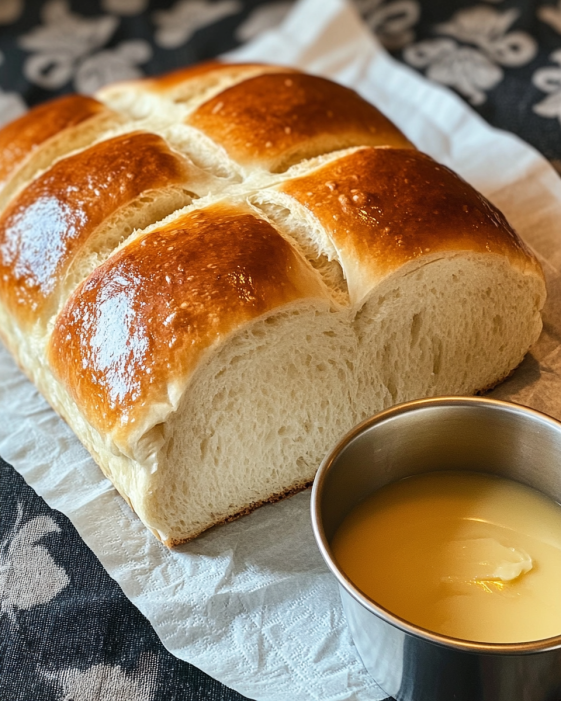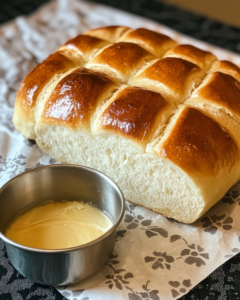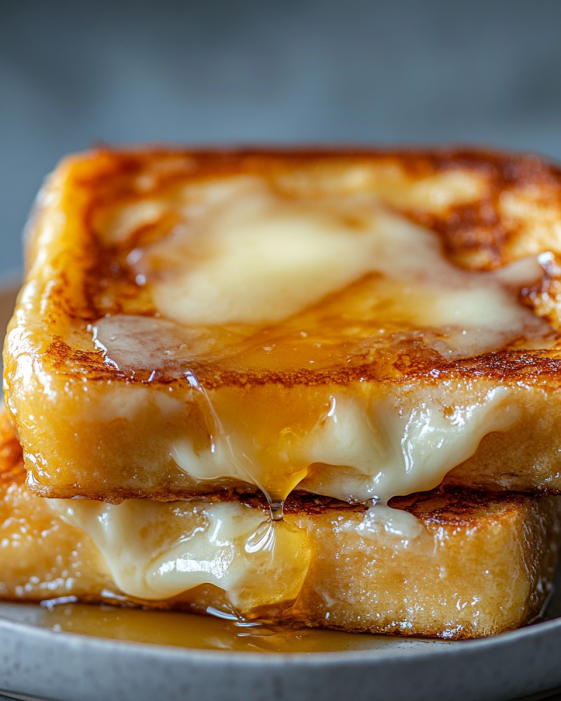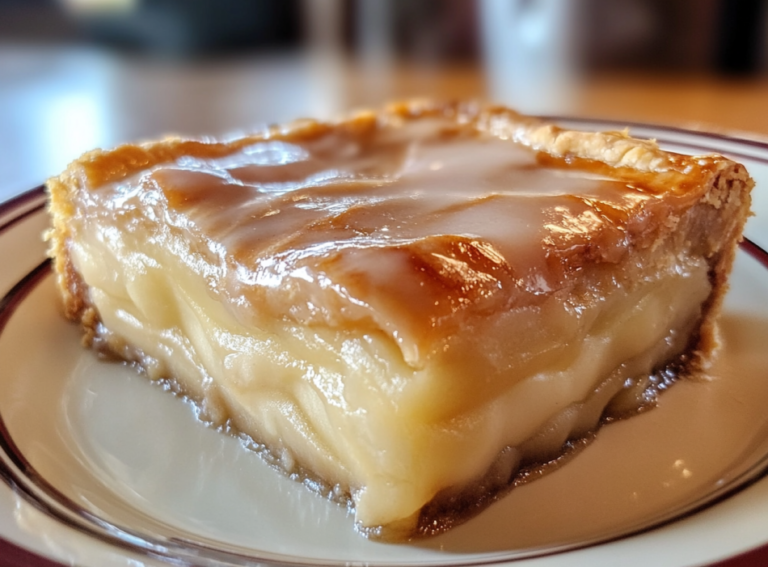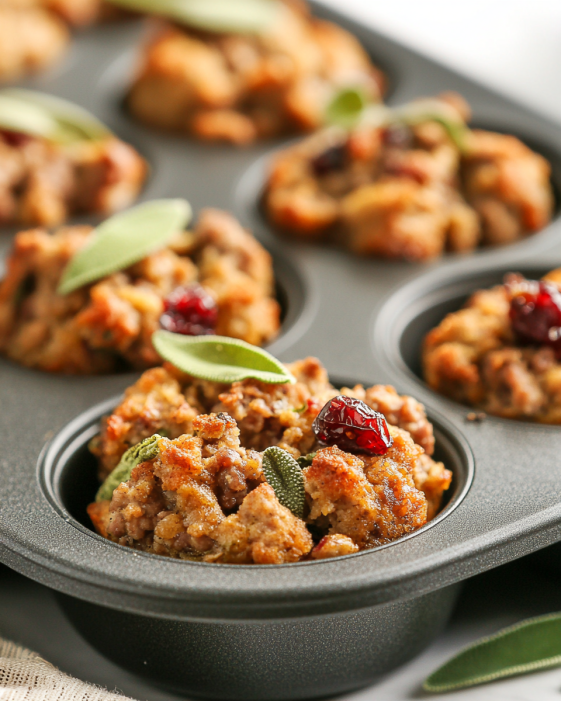Classic Amish White Bread
Soft, fluffy, and slightly sweet, this Classic Amish White Bread is a timeless recipe that delivers comfort in every bite. Perfect for sandwiches, toast, or just enjoying warm from the oven with butter, this bread is easy to make and always a crowd-pleaser. Whether you’re a seasoned baker or just starting out, this recipe is simple enough to guarantee success and versatile enough to suit your taste.
Why You’ll Love This Recipe
- Tender Texture: The soft crumb makes it ideal for slicing and stays fresh for days.
- Pantry Ingredients: No need for fancy ingredients—just staples you likely already have.
- Versatile Use: Serve it for breakfast, lunch, or as a side with soups and stews.
- Beginner-Friendly: Straightforward steps make this a perfect starter bread recipe.
- Customizable: Add herbs, seeds, or switch up the sweetness to make it your own.
Ingredients
- 1 cup warm water (110°F/45°C)
- ⅓ cup white sugar
- 2¼ teaspoons (1 packet) active dry yeast
- ¼ cup vegetable oil
- 1½ teaspoons salt
- 3 cups all-purpose flour
How to Make Classic Amish White Bread
Step 1: Activate the Yeast
In a large mixing bowl, dissolve the sugar in warm water. Sprinkle the yeast over the top and let it sit for 5-10 minutes until it’s frothy. This step ensures your yeast is alive and ready to work its magic.
Step 2: Mix the Dough
Stir in the vegetable oil and salt. Gradually add the flour, one cup at a time, mixing well after each addition until a soft dough forms.
Step 3: Knead the Dough
Turn the dough out onto a lightly floured surface and knead for 6-8 minutes, or until the dough is smooth and elastic. This step develops the gluten, which gives the bread its structure and chew.
Step 4: First Rise
Place the dough in a lightly greased bowl, turning to coat all sides. Cover with a clean kitchen towel and let it rise in a warm place for about 1 hour, or until doubled in size.
Step 5: Shape the Dough
Punch down the dough to release any air bubbles. Shape it into a loaf and place it in a greased 9×5-inch loaf pan. Cover and let it rise again for about 30 minutes, or until the dough rises just above the edge of the pan.
Step 6: Bake
Preheat your oven to 350°F (175°C). Bake the bread for 30-35 minutes, or until the top is golden brown and the loaf sounds hollow when tapped.
Step 7: Cool and Serve
Remove the bread from the oven and let it cool in the pan for 5 minutes. Transfer to a wire rack to cool completely before slicing.
Serving Suggestions
- Breakfast: Toast slices and spread with butter, jam, or honey.
- Lunch: Use for sandwiches with deli meats, cheese, or fresh veggies.
- Dinner: Serve alongside soups, stews, or casseroles for a comforting side.
Variations
Whole Wheat Option:
Swap up to half the all-purpose flour with whole wheat flour for a heartier texture.
Honey-Sweetened:
Replace the sugar with honey for a natural sweetness.
Herb Bread:
Mix in 1-2 teaspoons of dried herbs like rosemary, thyme, or oregano for a savory twist.
Seed Topping:
Sprinkle sesame seeds, poppy seeds, or oats on top before baking for added texture.
Cinnamon Swirl:
Roll the dough with a cinnamon-sugar mixture before shaping for a sweet breakfast loaf.
Storage and Reheating Tips
Room Temperature:
Store the bread in an airtight container or wrap tightly in plastic wrap for up to 3 days.
Refrigeration:
For longer storage, refrigerate the loaf in an airtight container for up to 1 week.
Freezing:
Wrap the loaf or individual slices in plastic wrap and place in a freezer-safe bag. Freeze for up to 3 months.
Reheating:
To refresh, warm slices in a toaster or wrap the loaf in foil and heat in a 350°F (175°C) oven for 5-10 minutes.
FAQs
How can I tell if the yeast is active?
Active yeast will foam and create a frothy layer on top of the warm water within 5-10 minutes. If this doesn’t happen, the yeast may be expired or the water temperature may be off.
Can I use bread flour instead of all-purpose flour?
Yes! Bread flour will give a slightly chewier texture, but all-purpose flour works perfectly for this recipe.
How do I prevent dense bread?
Make sure to knead the dough thoroughly to develop gluten and allow enough time for both rises. Avoid adding too much flour, as this can make the loaf dense.
Why did my bread rise too slowly?
Cooler room temperatures can slow the rising process. Place the dough in a warm spot, like near a sunny window or in an oven with just the light turned on.
Can I make this recipe in a bread machine?
Yes! Follow your bread machine’s instructions for adding ingredients. Use the basic white bread setting for best results.
Pro Tips for Success
- Warm Water: Ensure the water is between 105-110°F to activate the yeast without killing it.
- Don’t Rush the Rises: Allow the dough to rise fully for the best texture and flavor.
- Grease the Pan: Prevent sticking by lightly greasing the loaf pan before adding the dough.
Conclusion
This Classic Amish White Bread is a simple yet satisfying recipe that’s perfect for any occasion. With its soft texture and lightly sweet flavor, it’s a versatile loaf that’s sure to become a staple in your kitchen. Whether you’re making sandwiches, toast, or enjoying it fresh from the oven, this bread delivers comfort in every slice. Give it a try and savor the joy of homemade bread!

